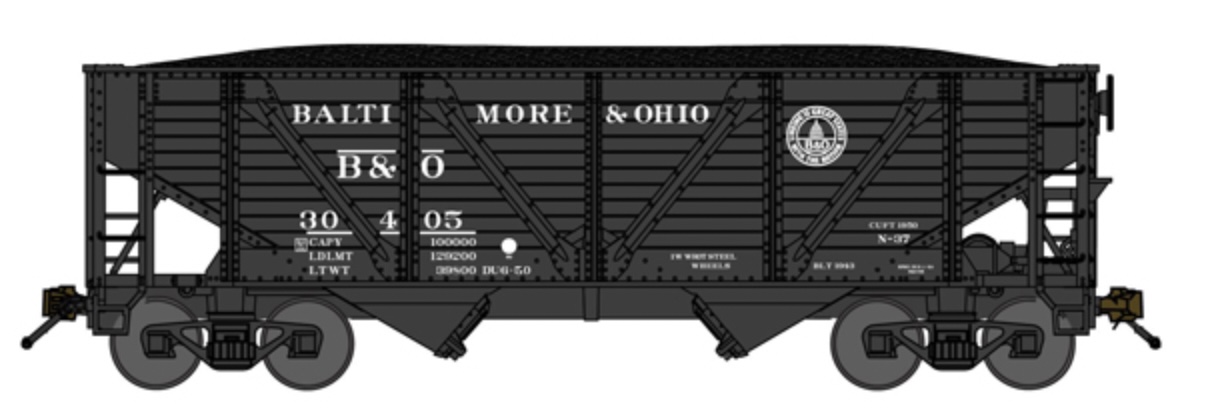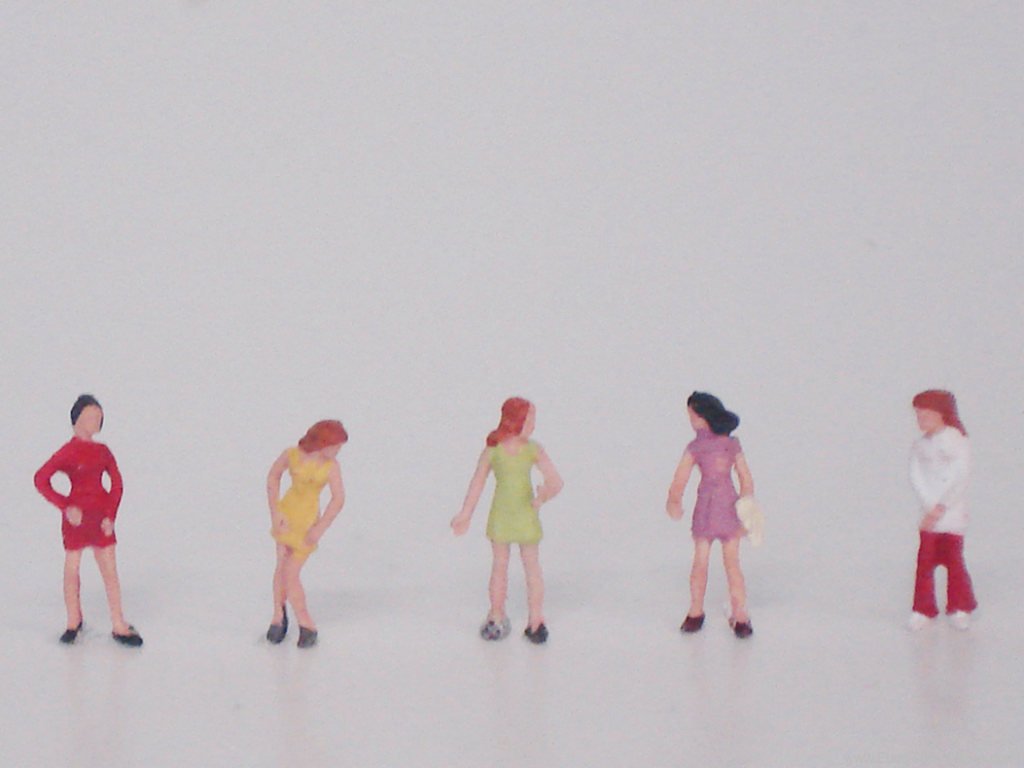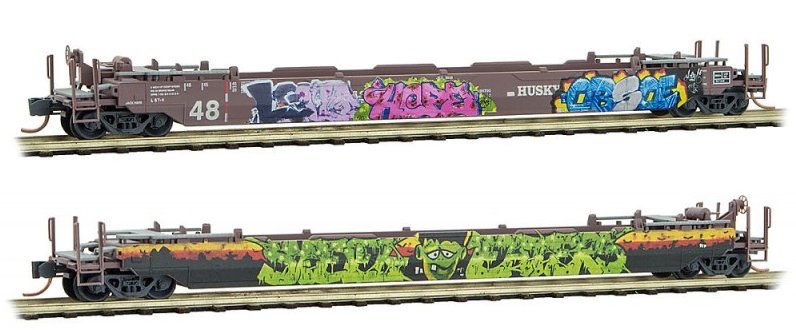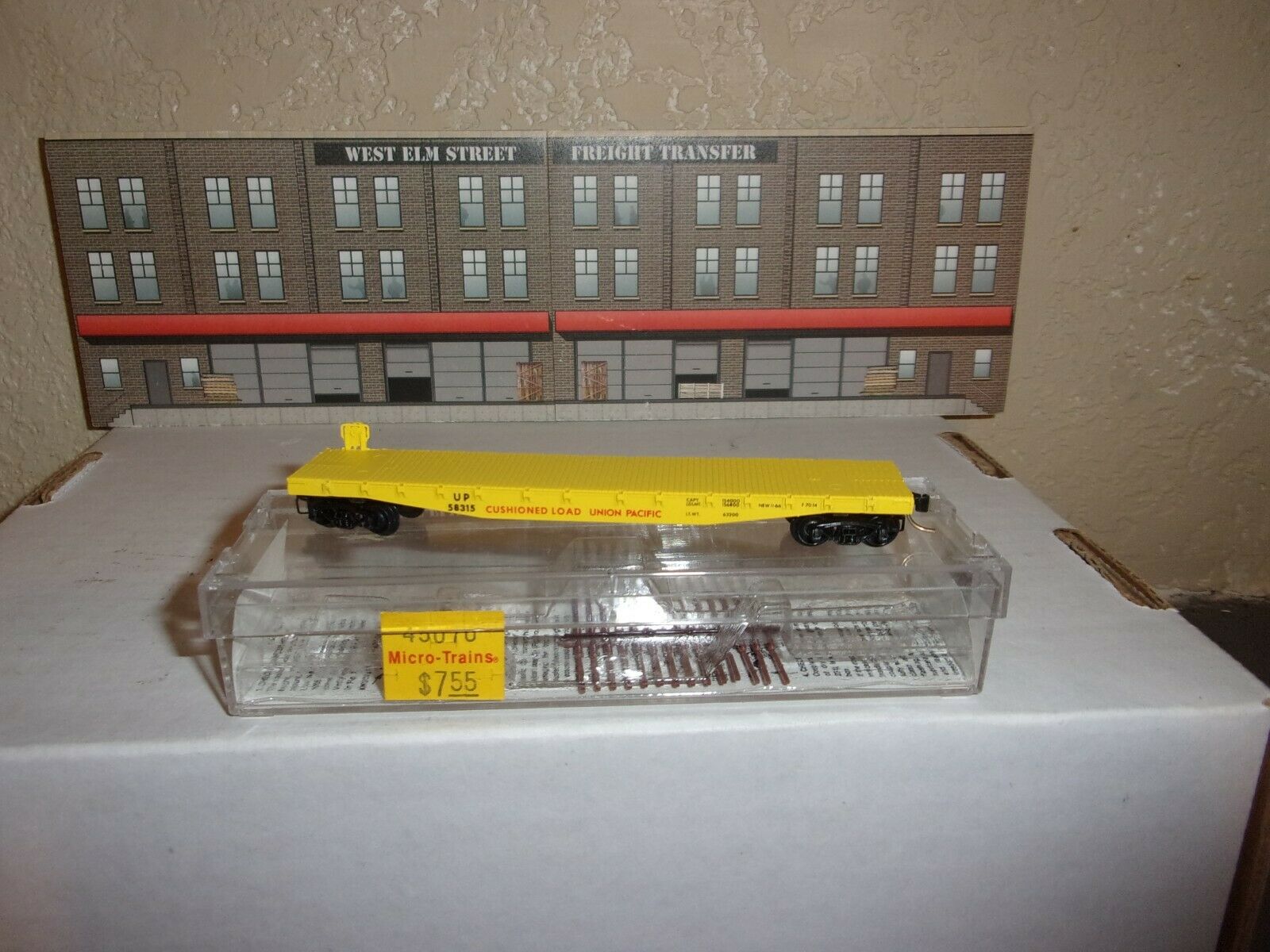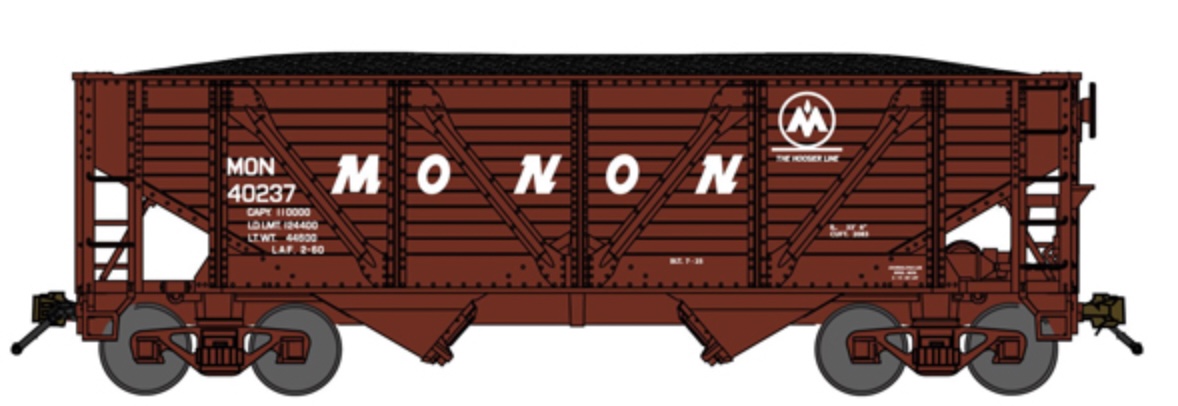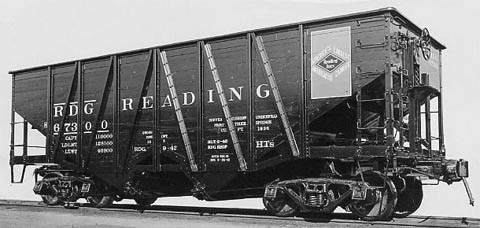Specific Item Information: Baltimore & Ohio received this group of 1,025 hoppers from Bethlehem Steel in 1943 and 1944. Beginning in 1946 they received this paint scheme with the “Linking 13 Great States With The Nation” logo. B&O’s dense network in West Virginia guaranteed they would be a major coal hauler, second only to PRR in tons of coal moved.
Model Information: Bluford Shops is proud to announce our third new body style in N scale for July 2017. This time we have 2-Bay War Emergency Composite Hoppers. These are the predecessors of the Rebuilt War Emergency Hoppers we announced last month. These cars were built during the Second World War with wood siding and slope sheets at the direction of the War Production Board in hopes of saving as much steel as possible for the war effort. This was especially the case with hoppers that were usually built with copper-bearing steel to resist corrosion. The car sides were built with the Pratt truss design using a combination of vertical and diagonal ribs. A majority were later rebuilt with steel replacing the wood components but some composite cars remained in service into the 1970s.
These ready-to-run cars feature: die cast slope sheet-hopper bay-center sill assembly; injection molded plastic sides, ends, and hopper doors; fully molded brake tank, valve and air lines; body mounted brake hose detail; load; body mounted magnetically operating knuckle couplers; close coupling; and Fox Valley Models metal wheels.
All road names will be available in multiple road numbers. For instance, order a single, a 2-pack and a 3-pack to get all six road numbers on a run. (Some road names will be available in just three road numbers.)
These ready-to-run cars feature: die cast slope sheet-hopper bay-center sill assembly; injection molded plastic sides, ends, and hopper doors; fully molded brake tank, valve and air lines; body mounted brake hose detail; load; body mounted magnetically operating knuckle couplers; close coupling; and Fox Valley Models metal wheels.
All road names will be available in multiple road numbers. For instance, order a single, a 2-pack and a 3-pack to get all six road numbers on a run. (Some road names will be available in just three road numbers.)
Prototype History: The story of these 2-Bay War Emergency Hoppers begins in 1942 when the War Production Board directed car builders to substitute wood for steel wherever possible in car superstructures. The familiar 2-Bay War Emergency Composite Hopper was a result of this directive. Those cars had wooden side sheets and end slope sheets (although the middle slope sheets remained steel.)
The wood siding was thicker than comparable steel sheeting and this reduced the capacity of the cars. While you could build ten composite cars with the steel from nine all-steel cars, it took more composite cars to move the same amount of coal. This combined with the more frequent repairs required by the composite cars soured the War Production Board on the design.
During 1944, the directive was set aside and cars that were on order were delivered with the familiar diagonal bracing but with all steel construction. After the war, as composite cars came due for serious maintenance, the wood side and slope sheets were replaced with steel. A large majority of the composite cars were rebuilt in this manner sometime during the 1950s.
From Bluford Shops
The wood siding was thicker than comparable steel sheeting and this reduced the capacity of the cars. While you could build ten composite cars with the steel from nine all-steel cars, it took more composite cars to move the same amount of coal. This combined with the more frequent repairs required by the composite cars soured the War Production Board on the design.
During 1944, the directive was set aside and cars that were on order were delivered with the familiar diagonal bracing but with all steel construction. After the war, as composite cars came due for serious maintenance, the wood side and slope sheets were replaced with steel. A large majority of the composite cars were rebuilt in this manner sometime during the 1950s.
From Bluford Shops
Road Name History: The Baltimore and Ohio Railroad (reporting marks B&O, BO) is one of the oldest railroads in the United States and the first common carrier railroad. It came into being mostly because the city of Baltimore wanted to compete with the newly constructed Erie Canal (which served New York City) and another canal being proposed by Pennsylvania, which would have connected Philadelphia and Pittsburgh. At first this railroad was located entirely in the state of Maryland with an original line from the port of Baltimore west to Sandy Hook. At this point to continue westward, it had to cross into Virginia (now West Virginia) over the Potomac River, adjacent to the confluence of the Potomac and Shenandoah rivers. From there it passed through Virginia from Harpers Ferry to a point just west of the junction of Patterson Creek and the North Branch Potomac River where it crossed back into Maryland to reach Cumberland. From there it was extended to the Ohio River at Wheeling and a few years later also to Parkersburg, West Virginia.
It is now part of the CSX Transportation (CSX) network, and includes the oldest operational railroad bridge in the USA. The B&O also included the Leiper Railroad, the first permanent horse-drawn railroad in the U.S. In later years, B&O advertising carried the motto: "Linking 13 Great States with the Nation." Part of the B&O Railroad's immortality has come from being one of the four featured railroads on the U.S. version of the board game Monopoly, but it is the only railroad on the board which did not serve Atlantic City, New Jersey, directly.
When CSX established the B&O Railroad Museum as a separate entity from the corporation, some of the former B&O Mount Clare Shops in Baltimore, including the Mt. Clare roundhouse, were donated to the museum while the rest of the property was sold. The B&O Warehouse at the Camden Yards rail junction in Baltimore now dominates the view over the right-field wall at the Baltimore Orioles' current home, Oriole Park at Camden Yards.
At the end of 1970 B&O operated 5552 miles of road and 10449 miles of track, not including the Staten Island Rapid Transit (SIRT) or the Reading and its subsidiaries.
Read more on Wikipedia.
It is now part of the CSX Transportation (CSX) network, and includes the oldest operational railroad bridge in the USA. The B&O also included the Leiper Railroad, the first permanent horse-drawn railroad in the U.S. In later years, B&O advertising carried the motto: "Linking 13 Great States with the Nation." Part of the B&O Railroad's immortality has come from being one of the four featured railroads on the U.S. version of the board game Monopoly, but it is the only railroad on the board which did not serve Atlantic City, New Jersey, directly.
When CSX established the B&O Railroad Museum as a separate entity from the corporation, some of the former B&O Mount Clare Shops in Baltimore, including the Mt. Clare roundhouse, were donated to the museum while the rest of the property was sold. The B&O Warehouse at the Camden Yards rail junction in Baltimore now dominates the view over the right-field wall at the Baltimore Orioles' current home, Oriole Park at Camden Yards.
At the end of 1970 B&O operated 5552 miles of road and 10449 miles of track, not including the Staten Island Rapid Transit (SIRT) or the Reading and its subsidiaries.
Read more on Wikipedia.
Brand/Importer Information: Bluford Shops began in 2007 as a side project of two model railroad industry veterans, Craig Ross and Steve Rodgers. They saw a gap between road names available on N scale locomotives but not available on cabooses. They commissioned special runs of Atlas cabooses in Atlantic Coast Line, Central of Georgia, Monon, Boston & Maine and Southern plus runs on Grand Trunk Western and Central Vermont on the MDC wooden cabooses. While these were in process, they began to develop their first all new tooling project, 86' Auto Parts Boxcars in double door and quad door editions in N scale. By January of 2008, Bluford Shops became a full time venture. Along with additional N scale freight cars and their own tooling for new cabooses, they have brought their own caboose line to HO scale. They also have their popular Cornfields in both HO and N. The future looks bright as they continue to develop new products for your railroad.
The town of Bluford in southern Illinois featured a small yard on Illinois Central's Edgewood Cutoff (currently part of CN.) The yard included a roundhouse, concrete coaling tower (which still stands) and large ice house. Reefer trains running between the Gulf Coast and Chicago were re-iced in Bluford. Things are more quiet now in Bluford with the remaining tracks in the yard used to stage hoppers for mines to the south and store covered hoppers. Intersecting the IC line in Bluford is Southern Railway's (currently NS) line between Louisville and St. Louis. Traffic on this single track line remains relatively heavy.
The town of Bluford in southern Illinois featured a small yard on Illinois Central's Edgewood Cutoff (currently part of CN.) The yard included a roundhouse, concrete coaling tower (which still stands) and large ice house. Reefer trains running between the Gulf Coast and Chicago were re-iced in Bluford. Things are more quiet now in Bluford with the remaining tracks in the yard used to stage hoppers for mines to the south and store covered hoppers. Intersecting the IC line in Bluford is Southern Railway's (currently NS) line between Louisville and St. Louis. Traffic on this single track line remains relatively heavy.
Item created by: CNW400 on 2021-10-21 15:50:35
If you see errors or missing data in this entry, please feel free to log in and edit it. Anyone with a Gmail account can log in instantly.
If you see errors or missing data in this entry, please feel free to log in and edit it. Anyone with a Gmail account can log in instantly.


